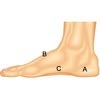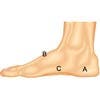Foot 411: The Basics


When it comes to skiing, success is often a factor of good boot fit. Sloppy fit or imprecise underfoot support compromises control of your skis. And if you’re experiencing pain, you might subconsciously—or even consciously—adjust your technique to avoid it. Stance problems are similarly troublesome. If your boots are poorly tuned, they might handle OK at lower speeds but be harder to control at higher speeds or in more aggressive maneuvers. Many discerning skiers use custom insoles and work with technicians to choose a boot that fits, then adjust it for performance and comfort. In addition to making basic modifications, boot techs can adjust boots to harmonize with your anatomy. They have many techniques: punching or grinding relief pockets, installing shims to reduce volume, analyzing your stance and making cuff-alignment or canting corrections. If you’re serious about your skiing—or just averse to pain—knowing more about your feet will help you to identify problems and potential solutions.
A. HEEL Must be securely seated on the footbed, with minimal up-and-down movement.
Excessive vertical movement of your heel can cause a “pump bump”—swelling at the back of the heel, which can calcify, exacerbating the problem. A pump bump can make a boot feel tight in the toes or loose in the heel because it forces the foot forward. Custom insoles can help prevent them. A bootfitter can punch a relief pocket in the shell to prevent further injury.
B. INSTEP The top of the foot, in front of the ankle.
Pressure on the instep and resulting numbness in the toes are common complaints from skiers with high insteps. Loosening your instep buckle will provide temporary relief, but there’s not much a bootfitter can do to help after the fact. If you have a high instep, take extra care to find a boot that fits well from the start.
C. ARCH A shock absorber for the foot.
Skiers with high arches often experience pain at the ball of the foot as well as arch cramps and/or a tight Achilles tendon. A heel lift (a wedge beneath the footbed) or custom insole can stabilize the foot and ease pain. Skiers with low arches are generally less flexible. In ski boots they often have navicular or inside-ankle pain. Shimming the liner secures the foot. Punching the liner and/or shell relieves pain. Custom footbeds might be of only moderate help.
[pagebreak]
A. ANKLE Perhaps the most important joint in skiing; must be able to flex and extend fully to allow the skier to maintain balance in uneven terrain.
Pressure here often results from an unstable, unbalanced foot and/or prominent joint bones. A custom footbed and a punch or grind usually relieve any pain. Insufficient or excessive flexion can be corrected by modifying a boot’s stiffness and stance. Heel lifts might also help.
B. HEEL BONE Also called the calcaneus; the foundation of good balance.
An outward tilt makes the foot drop inward,or pronate. Minor pronation is normal and aids shock absorption. Excessive pronation can cause foot, leg and arch cramps and make edging difficult. An inward curve of the heel bone makes the foot drop outward (supination). Skiers with supinated feet often catch their outside edges. Both conditions are best cured by a supportive custom insole.
C. NAVICULAR The boat-shaped bone on the inside of the foot, just above the arch.
A prominent navicular can be very painful in a ski boot. But pressure can usually be relieved by adding a heel lift, padding the liner or grinding the shell. In some cases, navicular pain caused by constant chafing can be eliminated by balancing the foot with a custom footbed.
D. FOREFOOT The widest part of the foot, comprising the five metatarsal bone heads. Used as a reference point in describing a boot’s interior width.
A tight fit here is painful; a loose one is imprecise. Either way, skiing suffers. Padding reduces volume bbut also muffles power transmission. Pain under the forefoot can be relieved with the installation of a metatarsal arch. Stretching and grinding of both liner and shell can easily provide more room. Avoid a sloppy fit here at all costs.
E. TOES Crucial for both lateral and longitudinal balance; must not be restricted.
Scrunched up toes get cold more quickly and can’t be used properly for balance. What’s more, bunions—the painful swelling of soft tissue—often result. Bunions typically occur at the side or top of the big toe or on the knuckles. If not corrected, they can calcify into bone. Deal with them immediately: Liner and/or shell modifications can easily relieve pressure.